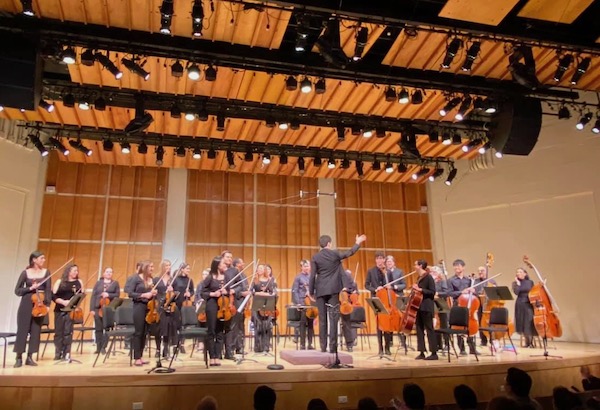Parlando’s fine playing speaks for itself at Merkin Hall

The word parlando has several meanings: In the original Italian, it is the gerund “talking,” and in a musical context it describes a declamatory style of singing.
Parlando is also the name of a new string orchestra, organized by young conductor Ian Niederhoffer, and talking is a key to its mission. As the program notes for the ensemble’s second concert, which took place Thursday night in Merkin Hall, explained, Parlando “is an ensemble created to bring educational and accessible classical music experiences to wider audiences. By integrating dialogue with historical and musical context within short programs, Parlando seeks to remove the barriers to entry to classical music concerts without compromising the music.”
Thursday night, the dialogue was twofold; Niederhoffer introduced each work—Franz Schreker’s Intermezzo, Leyendas: An Andean Walkabout by Gabriela Lena Frank, and Schoenberg’s Verklärte Nacht—and actor Robert Cuccioli read the Richard Dehmel poem that inspired Schoenberg, both to introduce the piece and as an interlude.
The concert showed that Parlando is a fine ensemble, and this kind of user-friendly presentation is more than welcome in the classical world. But at least on this occasion the performances were sharp and focused while the talking was less rewarding.
Everything built on the music-making, and Parlando hit the mark. They have a bright sound, full of texture and colors. Their playing of Schreker’s lovely Intermezzo was expressive and songful, they handled all the rhythmic and stylistic challenges Frank’s hybrid of classical and folk music threw at them, and Verklärte Nacht was full of passion for the music.
The issues were not execution but conception. The program had the theme “Dual Selves,” and that meant Niederhoffer had to explain what he termed the “dualities of self.” That proved somewhat confusing—he emphasized both Schreker’s Jewishness and the lack of Jewishness in the Intermezzo. Other points were less than revelatory—the fact that Frank’s mixed European/Asian/Andean heritage informs her piece, or the clear conflict and transformation in Verklärte Nacht.
There was also a cutesy rating system in the program. Each work had one or more grace note symbols after the title, and a note explained that they represented “a level of listening difficulty, like chili peppers at a Thai restaurant.” But the ratings seemed arbitrary, with one note for the Intermezzo, three for Leyendas, and two for Schoenberg—even though Frank’s music was the most accessible and energetic of all.
The youthful orchestra, some two-dozen strong, was more serious than that aspect of the presentation. They made an immediate impression with the size and the intense shine of their sound in the first notes of the Intermezzo. In only their second appearance, the Parlando players were clearly well prepared, with mostly steady intonation. There were a few wayward tunings at the latter end of Verklärte Nacht, but few ensembles can avoid that, as well as a musical and satisfying unanimity to their attacks and phrasing. All evening, Parlando played with the energy of musicians who are excited by what they are playing. Parlando’s playing was such that the music spoke entirely for itself.
Niederhoffer did hit on a compelling theme in passing when introducing Intermezzo; that many of Schreker’s peers fled pre-WWII Europe and settled in Hollywood, where they became pioneering film computers. And though written in 1901, Intermezzo is a stellar example of that sound; harmonically rich, soulful, expressing a dramatic narrative.
The same is true for Leyendas, a set of pictorial vignettes based around different aspects of Andean folk culture, and of course Verklärte Nacht, which in the 21st century can be heard as the blueprint for numerous noir and melodrama scores. Cuccioli’s graceful reading of the Dehmel poem served to enhance this feeling.






